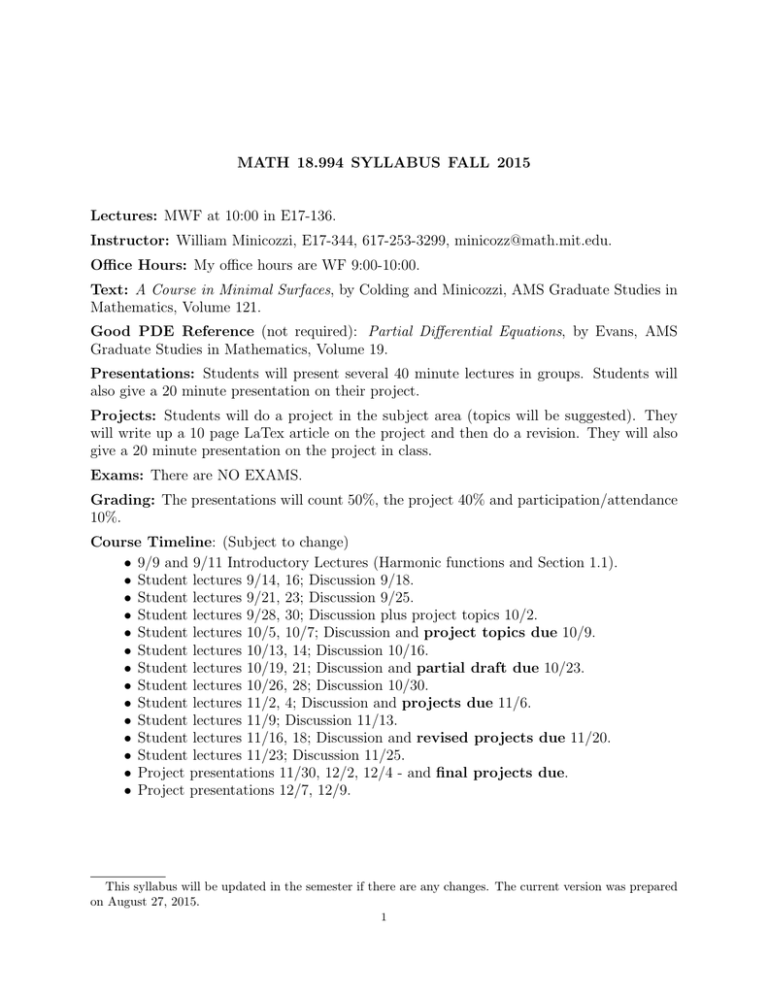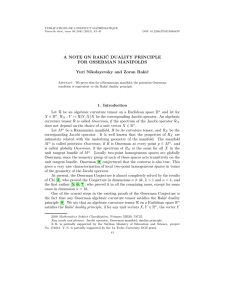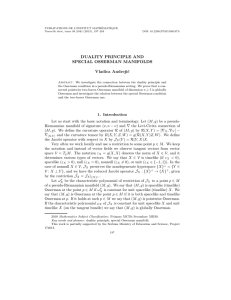MATH 18.994 SYLLABUS FALL 2015 Lectures: MWF at 10:00 in E17-136.
advertisement

MATH 18.994 SYLLABUS FALL 2015 Lectures: MWF at 10:00 in E17-136. Instructor: William Minicozzi, E17-344, 617-253-3299, minicozz@math.mit.edu. Office Hours: My office hours are WF 9:00-10:00. Text: A Course in Minimal Surfaces, by Colding and Minicozzi, AMS Graduate Studies in Mathematics, Volume 121. Good PDE Reference (not required): Partial Differential Equations, by Evans, AMS Graduate Studies in Mathematics, Volume 19. Presentations: Students will present several 40 minute lectures in groups. Students will also give a 20 minute presentation on their project. Projects: Students will do a project in the subject area (topics will be suggested). They will write up a 10 page LaTex article on the project and then do a revision. They will also give a 20 minute presentation on the project in class. Exams: There are NO EXAMS. Grading: The presentations will count 50%, the project 40% and participation/attendance 10%. Course Timeline: (Subject to change) • 9/9 and 9/11 Introductory Lectures (Harmonic functions and Section 1.1). • Student lectures 9/14, 16; Discussion 9/18. • Student lectures 9/21, 23; Discussion 9/25. • Student lectures 9/28, 30; Discussion plus project topics 10/2. • Student lectures 10/5, 10/7; Discussion and project topics due 10/9. • Student lectures 10/13, 14; Discussion 10/16. • Student lectures 10/19, 21; Discussion and partial draft due 10/23. • Student lectures 10/26, 28; Discussion 10/30. • Student lectures 11/2, 4; Discussion and projects due 11/6. • Student lectures 11/9; Discussion 11/13. • Student lectures 11/16, 18; Discussion and revised projects due 11/20. • Student lectures 11/23; Discussion 11/25. • Project presentations 11/30, 12/2, 12/4 - and final projects due. • Project presentations 12/7, 12/9. This syllabus will be updated in the semester if there are any changes. The current version was prepared on August 27, 2015. 1 2 18.994 FALL 2015 Student Lecture Topics: (1) Chapter 1: Sections 1.2 and 1.3 - Submanifolds and First Variation. (2) Chapter 1: Section 3 - Consequences of First Variation: Harmonicity, Convex Hull Property, Monotonicity and Meanvalue Inequalities. (3) Chapter 1: Section 4 and Exercise 5 - Gauss Map and the Catenoid. (4) Chapter 1: Section 6 - Weierstrass Representation. (5) Strong maximum principle for elliptic equations (pages 326 to 333 in Evans). (6) Chapter 1: Section 7 - Maximum Principle for Minimal Surfaces. (7) Chapter 1: Section 8 up to (but not including) 8.3 - Second Variation and Stability. (8) Chapter 1: 8.3 up to (not including) Proposition 1.39 - Stability and Bernstein’s Theorem. (9) Harnack inequality (pages 333-334 in Evans, PDE) and Fredholm Alternative (page 303 in Evans, PDE). (10) Chapter 1: Proposition 1.39 - Characterization of Stability. (11) Chapter 1: Appendix on the Bochner Formula. (12) Chapter 2: Simons’ equation - finish with (2.16). (13) Chapter 2: Simons’ inequality - start assuming (2.16). (14) Chapter 2: Section 2 - Choi-Schoen curvature estimate. (15) Chapter 2: Section 3 - Curvature and Area - finish with Section 3.2. (16) Chapter 2: Section 3 - Curvature and Area - Section 3.3. (17) Chapter 2: Section 4 - Schoen-Simon-Yau, part 1. (18) Chapter 2: Section 5 - Schoen-Simon-Yau, part 2. (19) Chapter 7: Section 2 - Hersch and Yang-Yau. (20) Chapter 7: Sections 3, 4 - Reilly Formula and Choi-Wang. Some suggested Project Topics: • The isoperimetric inequality for minimal surfaces (see, e.g., Chakerian, Proceedings of the AMS, volume 69, 1978). • The Sobolev inequality (see Chapter 3). • The Gauss-Bonnet Theorem (see Singer and Thorpe’s book). • Classify minimal surfaces in R3 whose Gauss map is one to one (see Theorem 9.4 in Osserman’s book). • Osserman’s proof of the Nirenberg Conjecture: A complete minimal surface whose Gauss map omits an open set must be flat (Theorem 8.1 in Osserman’s book). • Mean curvature flow and Huisken’s monotonicity formula (Huisken, JDG, volume 31, 1990). • Almgren’s Bernstein theorem in S3 : the only minimal spheres are great spheres (Almgren, Annals of Math., volume 84, 1966). • Constant mean curvature spheres and the Hopf problem (Hopf, Springer Lecture Notes in Math., volume 1000).








